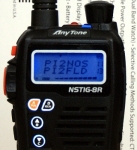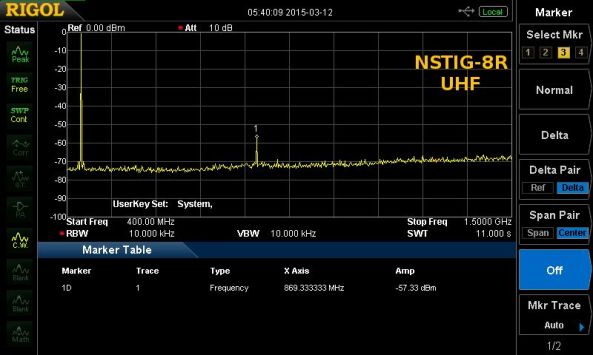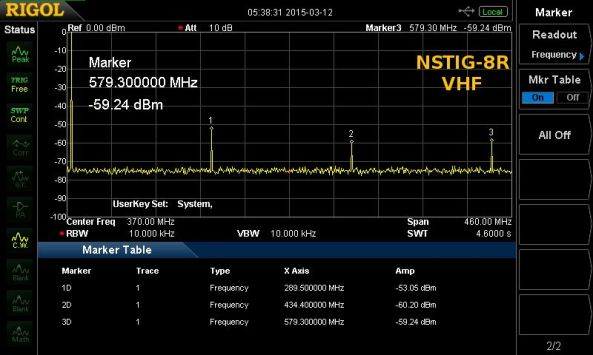 Review Anytone NSTIG-8R
Review Anytone NSTIG-8R
 The NSTIG-8R was the first radio I tried out, mainly because it came with a fully charged battery. I punched in some frequencies and took off on a 5-mile walk. The radio performed quite well.
The NSTIG-8R was the first radio I tried out, mainly because it came with a fully charged battery. I punched in some frequencies and took off on a 5-mile walk. The radio performed quite well.
In the box:
- Radio
- 1800 mAh battery
- Antenna (SMA female)
- Simple headset
- Charger
- AC adapter (110-240 Volts)
- Belt clip
- Wrist strap
- Manual
Factory specifications
Frequency range: [TX/RX] 136 – 174MHz, 400 – 520MHz
RX only: 68-108MHz (FM Broadcast)
Channel Capacity: 200 Channels
Channel Spacing: 25KHz (wide band)12.5KHz (narrow band)
Sensitivity: ≤0.25μV (wide band) ≤0.35μV (narrow band)
Operation Voltage: 7.4V DC ±20%
Battery: 1800mAh
Frequency steps (KHz): 2.5, 5, 6.25, 10, 12.5, 20, 25, 30 and 50
Antenna: SMA-Female
Accessory Connector: Kenwood 2-Pin standard
Stability: ±2.5 ppm
Output power: 5W / 1W
Size: 113×62×40mm (with battery)
Weight: 220g (with battery, antenna, belt clip)
Audio Power Output: 1000mW
Build quality
The first thing I noticed is the weight of the NSTIG-8R. While the dimensions of the radio are nearly identical to those of a UV-5R, this radio is quite a bit heavier: 129 grams vs 91 grams (without battery and antenna). With all the bells & whistles attached the scale shows 240 grams vs 209 grams. All in all the radio has a solid feel to it.
Side keys
The NSTIG-8R has three side keys also, and these can be programmed by the user. At default the upper key will switch on the flashlight, the middle one will show you the remaining battery voltage, and the last one will bypass the squelch (monitor).
Dual PTT
If you like you can reprogram one of the side keys to function as PTT for VFO B. The main PTT key is reserved for VFO A and can’t be re-assigned.
Display
 At default the three-color display (amber, blue or purple) shows two frequencies at the same time and will be in dual watch mode. There’s no ‘TDR’ option in the menu; if you want to switch off dual watch you press Function+Main to toggle between dual watch and single band mode.
At default the three-color display (amber, blue or purple) shows two frequencies at the same time and will be in dual watch mode. There’s no ‘TDR’ option in the menu; if you want to switch off dual watch you press Function+Main to toggle between dual watch and single band mode.
In single band mode you can switch between VFO A en B by just pressing the Main key. The system takes a little bit time to get used to.
 Nice touch: even when attached to your belt you can see which VFO is active. When the RX LED turns green the upper VFO is active, when turning blue the lower VFO is active. Contrary to a Baofeng you can select VFO mode or memory mode for each individual VFO.
Nice touch: even when attached to your belt you can see which VFO is active. When the RX LED turns green the upper VFO is active, when turning blue the lower VFO is active. Contrary to a Baofeng you can select VFO mode or memory mode for each individual VFO.
The S-meter is one that actually works. Meters on hand helds are never accurate enough to give a meaningful signal report, but at least you get a basic idea of the field strength.
Programming
Most of the programming can be done from the keypad, including alpha tags. The software is necessary to change the welcome message, or give the radio its own ID and pre-programmed DTMF sequences — something you will need if you decide to use individual or group calling. You can do a lot manually, which will come in handy in the field, but using the software will work faster and give you access to a lot of other options.
I think it’s really a shame that there’s no Help section in the software. With basic channel-editing software I couldn’t care less, but this program offers quite a few exotic options. I guess that figuring it all out will be left to us, after which we can document it on Miklor.com.
Memories
You can program 200 VHF/UHF frequencies and 99 FM broadcast frequencies. I won’t be able to fill that up easily, but I’m sure there will be others who won’t have any problems filling these up to the max.
Scanning
Most Chinese radios are poor, painfully slow scanners. For the first time in years I can report that scan speed is actually acceptable: about 4-5 channels/second. Not brilliant, but usable. The top models in the 8R series have a Fast Scan mode which clocks at 10 channels/second.
The NSTIG-8R can scan for CTCSS/DCS codes, and you can set VFO scanning limits.
Bugs
Haven’t been able to find one.
Various measurements
TX audio: loud and clear, just like the ANILE-8R. No complaints.
RX audio: Same story: loud and clear, with no noticeable distortion.
Sensitivity VHF (@ 145 MHz): -127 dBm (@ 50Ω, 12 dB SINAD).
Sensitivity UHF (@ 435 MHz): -125 dBm (@ 50Ω, 12 dB SINAD).
Frequency accuracy of this sample: VHF: 0 Hz, UHF -13 Hz.
Power output VHF (@145 MHz): 1.3 Watts / 4.9 Watts.
Power output UHF (@435 MHz): 1.1 Watts / 4.3 Watts.
Front-end: good, but not as good as the Wouxun KG-UV6D or QuanSheng TG-UV2.
Harmonic suppression: three measurable harmonics on VHF, varying between -53.05 dBm and -60.20 dBm, on UHF there’s only one at -57.33 dBm.
 Conclusion
Conclusion
I really like the NSTIG-8R. The design is refreshing, the radio offers more functionality than the average low cost radio, and it’s built like a tank.
The price of the radio is twice that of a Baofeng and half that of a basic(*) Yaesu FT-60. I understand people muttering about prices (it’s the first thing we hams do, it must be in our DNA), but the relation between price and quality is right on target here.
There’s always a choice: you go for the cheapest, for the best, or for something in between. Seen from that perspective the NSTIG-8R nicely fills the gap between Baofengs and Yaesu’s entry level radio.
(*) The Yaesu FT-60 does not come with a desktop charger, 1800 mAh battery or headset – you need to add about $120 for these accessories)
Price: $68.89 (Amazon)
More information: Anytone Tech














The inclusion of necessities such as a desktop charger is somewhere the Chinese manufacturers have really bested their Japanese counterparts.
When you figure out what you’re actually getting for the money, it’s pretty amazing.
Any chance you could post the power specs for the american 2m and 70 cm bands?
An amazing amount of features, especially for that price! I have a Yaesu VX 5. Its a three band radio that is so complicated to program, I cannot do it without the manual. Programming is usually done once and then the radio is left in that condition until I need to add something to it, another repeater for instance. If that happens a year or so later, I need the book to do it.
Hopefully this NSTIG 8R is more intuitive than the Vx5, to program.